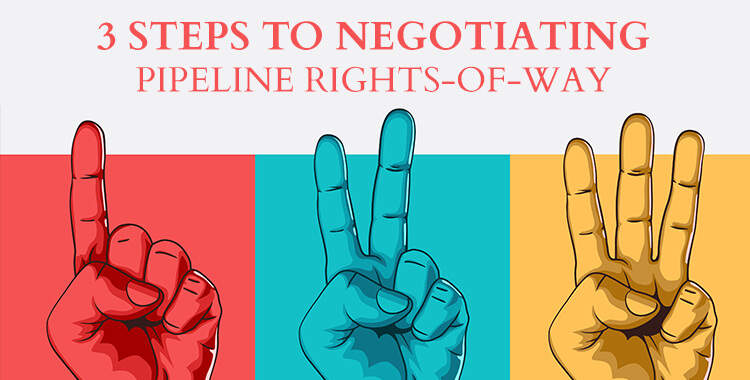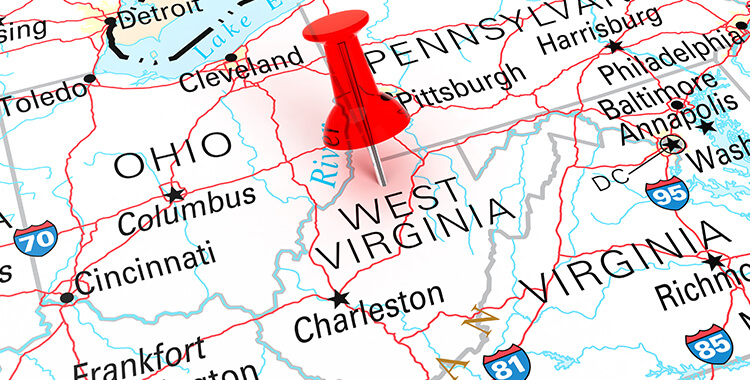
As an oil and gas lawyer, I am currently negotiating pipeline rights-of-way and easements on behalf of West Virginia and Ohio landowners. Truth be told, other than being in court, it’s my favorite type of case to handle.
Why?
Every property is unique and every property owner is unique. They’re never cookie-cutter negotiations and each pipeline case must be specifically tailored to the property and landowner. The truth is that can be challenging. However, over my years of experience negotiating pipline rights-of-way, I have developed a 3-step process to not only make sure my clients’ concerns are met but that my clients receive the very best deal possible, including the greatest compensation.
Step 1: Get the Exhibit Right
Each and every oil and gas pipeline right-of-way and easement proposal includes a map of the property with the proposed route of the pipeline right-of-way. That map is referred to as the Exhibit A. Before talking about price or any property-related or other contract terms, the landowner must, must, must get the exhibit right.
Is the route of the pipeline right-of-way and easement acceptable to the landowner? Is it going through the middle of a hayfield rather than the edge? Is it going to take out valuable timber that can be avoided? Is it going to be too close to a home or other structure?
Long story short, the landowner must determine the impact of the oil and gas pipeline right-of-way and easement route on their property. If the landowner has any concerns, they should be brought to the pipeline company to determine if they can alter their route to address those concerns.

Once a mutually acceptable route is determined, the landowner must insist that the footage of the pipeline right-of-way and easement is specifically stated in the exhibit. That footage should be the basis for compensation. Know that the pipeline company will not state the “slope” footage of the pipeline right-of-way and easement. It will state the linear footage or “as the crow flies.”
Keep in mind that this does not only apply to the pipeline right-of-way and easement. It applies to any of the pipeline company’s proposed use for the property, including, but not limited to access roads (temporary or permanent), workspaces and additional workspaces (including lay down yards), and facilities (valve sites, compressors, etc.). What I tell the pipeline company is if you want to have the use of any of these items, put it on the exhibit so my client can consider it. If it’s not on the exhibit, the pipeline company is not getting it and the pipeline right-of-way and easement agreement will reflect that. If the pipeline company seeks an access road, workspace, or facility site, make sure you have the footage for any access road and the acreage for any workspaces or facility sites.
Step 2: Get the Best Price
Once you have the exhibit right, you’ll know what the pipeline company is seeking. You can then start determining what price you’re going to seek for each item depicted on the exhibit. Let’s assume that there is a pipeline right-of-way and easement of 1,000 feet, a temporary access road of 650 feet, and workspaces of 1.5 acres included on the exhibit. Your demand should be $X/foot/pipeline for the pipeline right-of-way and easement, $Y/foot for the temporary access road, and $Z/acre for the workspaces.

The question is how do you determine what price for the pipeline right-of-way and easement, temporary access road, and workspaces? That is difficult for me to answer. If you ask the pipeline company, they may say they pay the going rate of $1/inch diameter of the pipeline/foot or some other “going rate.” Don’t fall into that negotiating pipeline trap! The truth is the value of pipeline rights-of-way and easements vary wildly depending on any number of circumstances.
The key word is leverage! How much leverage do you have in the negotiations? What it comes down to is “wants” versus “needs.” If the pipeline company “wants” to use your property for a pipeline but has alternative routes without use of your property, you may not have much leverage. If the pipeline company “needs” your property to complete a right-of-way route and is without good alternatives, you probably have a great deal of leverage. How do you determine whether you are a “want” versus a “need” is more of an art than a science.
With my clients, I perform a great deal of research to make an educated determination as to whether my client’s property is a want versus a need. I consult WV Department of Environmental Protection resources, Pipeline Plus, and other resources to determine where well development is taking place that needs to be connected to pipelines. I also rely heavily on GIS and topography mapping as well as contacts within the industry to help me connect the dots from the publicly available information. I’ll also check the county recorder’s office to determine whether adjoining landowners have recently signed any agreements that have been recorded and check their exhibits.
Let’s look at some examples.
If the pipeline company is seeking 3,000 feet of pipeline right-of-way and easement on your property, you’ll very likely have more leverage than your neighbor who only has 300 feet on his property. That’s an easy one. On the flip side, maybe your neighbor with only 300 feet of pipeline right-of-way and easement is the only reasonable place to cross a ridge up and down. He might not have a lot of footage but it might be the only reasonable place to cross that ridge. Let’s also assume that your neighbor’s property is very close to a well pad that is being connected. The pipeline company may not have many options to route around him because of the close proximity to the well pad. If yours is somewhere in the middle of the complete right-of-way and easement, the pipeline company will very likely have much better alternative options. Lastly, keep in mind who the pipeline company is. Some are much more willing to pay a higher price than seek alternatives. Others are much more willing to seek alternatives than pay a higher price.
These are just a few of the many, many pieces of information that I’d collect to determine how much leverage my client has when negotiating pipeline right-of-way. It could take weeks to put that information together, discuss with the pipeline company landman, and hear back from people within the industry and other landowners. Once you determine your leverage you can determine your “demand.” Your demand is a function of your leverage. High leverage = high prices. Low leverage = lower prices. However, the higher price you demand, the more risk you run of the pipeline company walking away from the negotiation without response.

Let’s say you determine you have good leverage. You might make a demand of $100/foot/pipeline for the right-of-way and easement, $20/ft. for the temporary access road, and $6,000/acre for the workspaces. Consult the footages and acreage stated in your exhibit to determine the total demand amount. Then your negotiations are off and running. Get the highest price possible and make sure that whatever price you agree to is worth it to you to live with the pipeline and the effects to you and your property.
A note on the price for the pipeline right-of-way and easement price: make sure you get paid PER PIPELINE and not one rate for the right-of-way. This is extremely important. The pipeline company will almost always seek to pay one rate for the right-of-way and easement, whether they install one pipeline or ten pipelines. You want paid for each pipeline. The more pipelines that are installed, the more valuable the right-of-way is for the pipeline company. The more valuable it is for the company, the more valuable it should be for the landowner. So, when the pipeline company says it will pay you $100/ft., make sure it’s $100/ft. for each pipeline installed.
Step 3: Get an Agreement that Protects You
Assuming that you and the pipeline company come to an agreement on the exhibit and the price to be paid for the pipeline right-of-way and easement and any access roads, workspaces, and facility sites, make sure that the agreement protects you. As a starting point, I always include language in my clients’ agreements that strictly limits the pipeline company’s use of the property to those areas explicitly depicted and defined on the exhibit. That is why getting the exhibit right is so important! Also, how will the property be restored? What will happen to brush, stumps, timber, etc? Will the timber be stacked? Where? What kind of seed will be used? Fertilizer? Will it impact any livestock? Water sources? What about access to a home or a barn on the other side of the right-of-way and easement? Will temporary access need to be provided? These questions and many more must be thoroughly considered and answered.

Also pay special attention to any option language in the agreement. Most pipeline right-of-way and easement agreements are structured as options. The pipeline company will seek to have you sign a document but will only pay a relatively small sum (or nothing at all at signing). They will only pay the agreed upon price if and when it commences construction for the pipeline.
Many proposed options give the pipeline company 5 or 10 years to commence construction. I’ve even seen option terms without expiration. In the meantime, your property is tied up and restricted. Make sure you are paid something substantial at signing for the option and strictly limit the option period.
Whatever you agree to in the course of these negotiations, make sure you get it in writing as part of the agreement! I can’t tell you how many times people have come into my office and told me that the landman promised this or promised that. When I ask to see the agreement and they tell me it’s not in there, I have to deliver the bad news that there’s likely nothing we can do. My rule of thumb is that if it’s not in writing, it didn’t happen.
GKT Negotiating Pipeline Attorney
While my 3-step process of negotiating pipeline rights-of-way is simple in concept, it’s not simple in practice. I could write 20 more pages on the ins and outs of negotiating a pipeline right-of-way and easement agreement. These are just some very basic pointers to keep in mind if you are considering negotiating your own pipeline right-of-way and easement agreement.
Of course, I urge anyone who has been approached by a pipeline company to seek the advice and representation of an attorney. More precisely, they should seek the advice and representation of an experienced oil and gas attorney like myself. These negotiations can be and often are very complex and it takes the right approach and experience to get the best price and the best terms.
GKT has represented hundreds of landowners on pipeline right-of-way and easement negotiations for over a decade. We have the knowledge, experience, and relationships to make sure you receive top dollar and an agreement on your terms. If you’ve been approached about a pipeline right-of-way, give me a call at (304) 845-9750 or live chat with us 24/7 at GKT.com. Of course, I’d be happy to set up a free, no-obligation consultation at your convenience.


